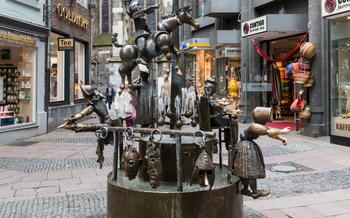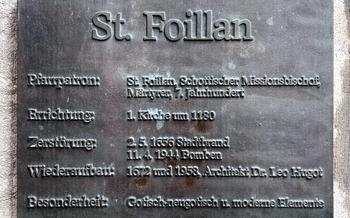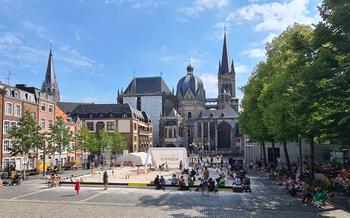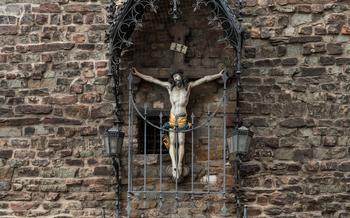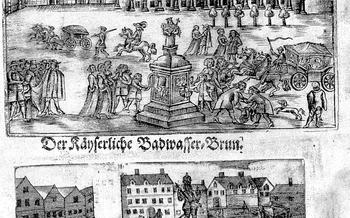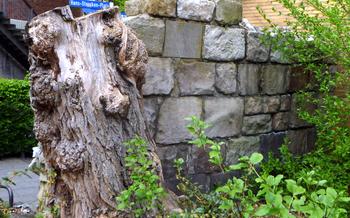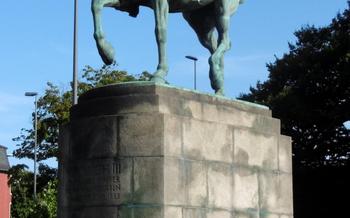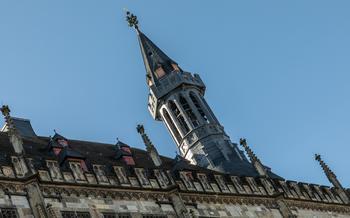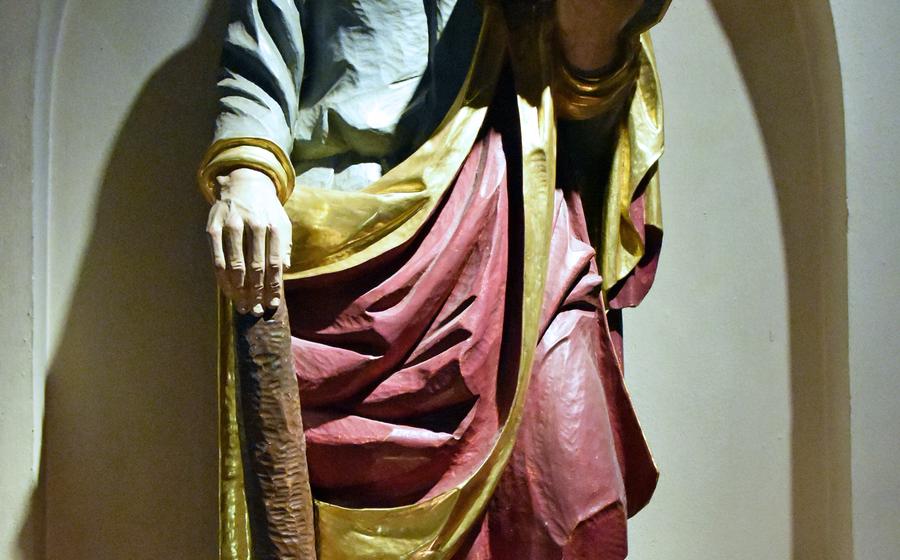
Marschiertor, another medieval city gate
- Marschiertor: Symbol of Aachen's Medieval Past
- Exploring the Marschiertor
- Historical Context: Aachen's City Walls
- Architectural Details: A Closer Look
- Marschiertor's Role in Trade and Commerce
- Witnessing Historical Events
- Preservation and Restoration Efforts
- The Marschiertor Today: A Cultural Landmark
- Events and Activities at the Marschiertor
- Exploring the Surroundings
- Marschiertor in Literature and Art
- Planning Your Visit: Practical Information
- Tips for Photographers
- Accessibility for Visitors with Disabilities
- Insider Tip: Hidden Gem Nearby
Marschiertor: Symbol of Aachen's Medieval Past
Built in the 13th century, the Marschiertor stands as a testament to Aachen's rich medieval history. This impressive gate tower was once part of the city's fortifications, serving as a crucial defense mechanism against attacks and invasions. Its sturdy construction, featuring a gate tower, round towers, and a pointed arch, reflects the architectural prowess of the time. Over the centuries, the Marschiertor has witnessed countless historical events, serving as a customs post, a gateway for trade and commerce, and a backdrop for coronations and religious processions. Today, meticulously restored and preserved, the Marschiertor stands as a cultural monument, inviting visitors to explore its fascinating past and immerse themselves in the medieval heritage of Aachen.
Exploring the Marschiertor
Visitors to the Marschiertor can embark on a journey through time, immersing themselves in the gate's rich history and architectural splendor. Guided tours led by knowledgeable historians provide a deeper insight into the gate's construction, its role in Aachen's defense, and the many historical events it has witnessed. Multimedia exhibits bring the gate's past to life, showcasing interactive displays and visual presentations that illuminate its significance in Aachen's history.
For a breathtaking perspective, visitors can climb the gate's tower, ascending a winding staircase to reach the rooftop. From this vantage point, panoramic views of Aachen unfold, revealing the city's iconic landmarks and the surrounding landscape. The Marschiertor also hosts changing exhibitions on various historical and cultural topics, offering visitors the opportunity to delve into different aspects of Aachen's heritage and culture.
Historical Context: Aachen's City Walls
As part of Aachen's impressive fortifications, the Marschiertor played a pivotal role in protecting the city from external threats. These city walls, erected during the Middle Ages, served as a defense mechanism against potential invasions and attacks. The Marschiertor was one of several gates that provided controlled access to the city, allowing for the regulation of movement and trade. Today, visitors can still admire the remaining sections of the city walls, which stand as testaments to Aachen's rich history and its strategic importance in medieval times.
Architectural Details: A Closer Look
The Marschiertor is a remarkable example of medieval architecture, showcasing a blend of Romanesque and Gothic styles. Its sturdy gate tower dominates the structure, featuring a crenellated top and machicolations—openings in the floor that allowed defenders to drop objects on attackers below. The tower is flanked by two round towers, adding strength and symmetry to the gate's design. The central arch, a defining feature of Gothic architecture, completes the gate's imposing presence.
The tower's crenellated top, with its series of evenly spaced indentations, served as a defensive feature, providing a platform for soldiers to stand and defend the gate from attack. Machicolations, strategically positioned above the gate's entrance, allowed defenders to drop stones, boiling water, or other objects onto attackers attempting to breach the gate.
The round towers, with their slightly tapered shape and narrow windows, provided additional defensive capabilities. Their circular form made them more resistant to attack, while the narrow windows limited the vulnerability of the gate to projectiles.
The pointed arch, a characteristic element of Gothic architecture, adds a touch of elegance and lightness to the gate's overall design. The arch's upward curve creates a sense of height and grandeur, drawing the eye towards the heavens.
Marschiertor's Role in Trade and Commerce
The Marschiertor played a crucial role in Aachen's economy as a customs post. Merchants and traders from near and far passed through the gate, bringing goods and fostering economic growth. Taxes collected at the gate contributed to the city's revenue, supporting various civic projects and improvements. The area around the Marschiertor bustled with market activities, where vendors sold their wares and buyers haggled for the best prices. The gate's strategic location on trade routes connecting Aachen to other regions facilitated the movement of goods and people, contributing to the city's prosperity and establishing it as a significant trading hub.
Witnessing Historical Events
Standing as a silent witness to the passage of time, the Marschiertor has seen its fair share of historical events unfold within its vicinity. The gate served as a grand entrance for the coronations of Holy Roman Emperors, a tradition that took place in Aachen for centuries. These coronations were elaborate ceremonies that drew dignitaries and royalty from across the realm. The gate's sturdy walls echoed with the sound of trumpets, cheers, and the proclamations of new rulers.
Beyond coronations, the Marschiertor played a role in religious processions and festivals. The gate marked the starting or ending point for these colorful parades, which filled the streets with music, dance, and vibrant costumes. The gate's presence added solemnity and grandeur to these religious celebrations.
The Marschiertor also bore witness to the ravages of war and conflict. Over the centuries, Aachen faced sieges and battles, and the gate served as a defensive barrier against invading forces. The gate's sturdy construction and strategic location made it a crucial point of defense for the city. Cannonballs and other battle scars can still be seen on the gate's exterior, a testament to its resilience and the turbulent history it has endured.
As rulers and dynasties changed hands, the Marschiertor stood as a symbol of transition. It marked the passing of power from one era to another, witnessing the rise and fall of empires and the shifting political landscape of the region. The gate's enduring presence served as a reminder of the continuity of Aachen's history and its ability to adapt to changing times.
Preservation and Restoration Efforts
Over time, the Marschiertor has undergone significant wear and tear due to its exposure to the elements, conflicts, and the passage of time. To preserve its historical integrity and architectural beauty, the gate has undergone several meticulous restoration projects.
In the 19th century, extensive restoration efforts were carried out to address structural issues and restore the gate's original appearance. These efforts involved repairing damaged stonework, rebuilding sections of the gate, and reinforcing its foundations.
More recently, in the 1980s and 1990s, another round of restoration projects was undertaken. These projects focused on restoring the gate's exterior and interior, including cleaning and repairing the stonework, replacing deteriorated elements, and upgrading the gate's infrastructure.
As a result of these dedicated restoration efforts, the Marschiertor stands today as a well-preserved monument, retaining its historical character and architectural grandeur. Ongoing maintenance and preservation measures ensure that this iconic gate continues to stand as a symbol of Aachen's rich heritage and cultural identity.
The Marschiertor Today: A Cultural Landmark
Recognized as a cultural heritage site of national importance, the Marschiertor stands as a testament to Aachen's rich past. Its historical significance attracts visitors interested in exploring the city's medieval heritage. The gate's architectural grandeur and well-preserved condition make it a popular destination for history buffs and architecture enthusiasts alike.
Beyond its historical value, the Marschiertor serves as an educational resource for learning about medieval history. Guided tours provide visitors with insights into the gate's construction, defensive features, and role in Aachen's development. Educational programs and workshops are also organized to engage students and the general public in the study of medieval history and architecture.
As a symbol of city pride, the Marschiertor represents Aachen's cultural identity and heritage. It is featured prominently in the city's coat of arms and is often used as a symbol in local events and celebrations. The gate's enduring presence in the heart of Aachen reminds its citizens and visitors of the city's rich history and cultural legacy.
Events and Activities at the Marschiertor
The Marschiertor is not just a historical monument but also a vibrant venue for cultural events and activities. Throughout the year, the gate and its surroundings come alive with a variety of programs that celebrate Aachen's heritage and culture.
One of the highlights is the historical reenactments that bring the gate's past to life. Costumed actors portray medieval merchants, soldiers, and nobles, engaging visitors in immersive storytelling and interactive experiences. These reenactments offer a unique glimpse into the daily life and customs of Aachen's medieval era.
The Marschiertor also serves as a stage for cultural performances. Concerts, plays, and other shows are held within the gate's premises, creating an intimate and atmospheric setting. From classical music recitals to contemporary theater productions, there is something for everyone to enjoy.
During special occasions, festive markets take place around the Marschiertor. These markets showcase local crafts, delicacies, and traditional entertainment. Visitors can browse stalls selling handmade goods, indulge in culinary delights, and soak up the lively atmosphere.
The Marschiertor is also a popular venue for public gatherings and celebrations. Whether it's a city festival, a music event, or a community gathering, the gate provides a central meeting point for people to come together and enjoy shared experiences.
By hosting these diverse events and activities, the Marschiertor not only preserves its historical significance but also contributes to the cultural vitality of Aachen. It is a place where history, heritage, and community spirit converge, creating a vibrant and engaging space for both locals and visitors alike.
Exploring the Surroundings
Just a short walk from the Marschiertor, visitors can explore several other landmarks that showcase Aachen's rich history and culture. The magnificent Aachener Dom, also known as Aachen Cathedral, is a UNESCO World Heritage Site and one of the most significant architectural landmarks in Germany. The cathedral is renowned for its stunning Gothic architecture, intricate carvings, and historical significance as the coronation church for many Holy Roman Emperors.
Another nearby attraction is the Elisenbrunnen, a historic fountain and spa facility. Built in the 19th century, the Elisenbrunnen is a symbol of Aachen's spa culture and features a beautiful rotunda surrounded by lush gardens. Visitors can enjoy the healing properties of the mineral-rich waters or simply relax and admire the architectural beauty of the fountain.
The Rathaus Aachen, or Aachen City Hall, is another must-see attraction near the Marschiertor. This impressive building, constructed in the 14th century, showcases a blend of Gothic and Renaissance architectural styles. The Rathaus is home to the city's administration and is open to the public for guided tours, offering a glimpse into Aachen's political and historical significance.
The area surrounding the Marschiertor is also a vibrant hub for shopping and dining. Visitors can find a variety of shops offering local specialties, souvenirs, and designer goods. There are also numerous restaurants, cafes, and bars catering to various tastes and budgets, offering a culinary journey through Aachen's diverse culinary scene.
Marschiertor in Literature and Art
The Marschiertor has served as a source of inspiration for numerous literary and artistic works. In literature, the gate has been mentioned in historical novels and poems, often as a symbol of Aachen's rich history and cultural heritage. Poets have captured the gate's grandeur and significance in their verses, while novelists have used it as a setting for historical events and tales of adventure.
In the realm of art, the Marschiertor has been depicted in paintings, engravings, and other artworks. Artists have been drawn to the gate's unique architectural features and its historical symbolism. Paintings of the Marschiertor often showcase its imposing presence and its role in the city's landscape. Engravings and sketches capture the intricate details of the gate's carvings and ornamentation.
The Marschiertor's presence in literature and art reflects its deep cultural significance in Aachen. It is a symbol of the city's identity and a reminder of its rich historical past. The gate continues to inspire artists and writers today, serving as a muse for creative expression and a source of historical and cultural exploration.
Planning Your Visit: Practical Information
The Marschiertor is conveniently located in the heart of Aachen, near the city center, making it easily accessible by foot, public transportation, or car. The gate is generally open to the public during daylight hours, and there may be a small admission fee for guided tours or special events.
Before your visit, it is recommended to check the official website of the Marschiertor or the Aachen tourism office for the most up-to-date information on opening hours, admission fees, and any special events or exhibitions that may be taking place.
Tips for Photographers
For photography enthusiasts, the Marschiertor presents a wealth of opportunities to capture its architectural grandeur and historical significance. To make the most of your visit, consider the following tips:
-
Best Angles: Explore different angles to capture the gate's imposing presence. Stand directly in front for a classic shot, or move to the side to highlight its height and depth. Don't forget to look for interesting perspectives, such as low-angle shots that emphasize the gate's scale or high-angle shots that showcase its rooftop details.
-
Lighting Conditions: The Marschiertor's appearance changes throughout the day as the light shifts. Visit at sunrise or sunset to capture the warm glow of golden hour, or come at night to see the gate illuminated against the dark sky. Each time of day offers a unique opportunity to capture the gate's essence.
-
Composition Techniques: Experiment with different composition techniques to create visually appealing images. Try using leading lines, such as the gate's archway or the cobblestone streets, to draw the viewer's eye into the photo. Incorporate elements of the surrounding environment, such as trees, people, or other buildings, to add depth and context to your shots.
-
Storytelling Through Photos: Use your photographs to tell the story of the Marschiertor and its significance. Capture details that convey its historical importance, such as close-ups of the gate's carvings or weathered surfaces. Include people interacting with the gate to add a human element to your images. By capturing both the grandeur and the intimate details of the Marschiertor, you can create a visual narrative that brings its history to life.
Accessibility for Visitors with Disabilities
The Marschiertor is committed to providing an inclusive and accessible experience for all visitors. Wheelchair users can easily navigate the gate's premises thanks to ramps and elevators. Guided tours specifically designed for visitors with disabilities are available upon request, ensuring that everyone has an opportunity to learn about the gate's history and significance. Assistance dogs are warmly welcomed at the Marschiertor, providing support and companionship to their owners. Restrooms and other facilities are designed to be accessible and inclusive, catering to the needs of all visitors. With these thoughtful provisions, the Marschiertor ensures that everyone can fully enjoy and appreciate this historic landmark.
Insider Tip: Hidden Gem Nearby
Venture beyond the Marschiertor and uncover the hidden gem of St. Adalbert Church, located just a short stroll away. This remarkable church stands as a testament to Aachen's rich architectural heritage, blending Romanesque and Gothic elements in a captivating display. Dating back to the 10th century, St. Adalbert Church holds a significant place in the city's history as one of its oldest churches.
Intricate carvings adorn the church's exterior, inviting visitors to step inside and marvel at the vaulted ceilings and exquisite stained-glass windows. The church's serene atmosphere provides a tranquil retreat from the bustling city center, offering a moment of contemplation and reflection.
Whether you're a history buff, an architecture enthusiast, or simply seeking a peaceful sanctuary, St. Adalbert Church is a hidden gem not to be missed. Let this architectural masterpiece transport you back in time as you explore its unique charm and historical significance.

